Updated Monday, Sept. 14, at 12:49 EST
TAKEAWAY: Work flow in the newsroom is one hot topic, it is also one very hot button when it comes to how traditional editors see the role of news in a multiplatform environment. The who does what and when can help every newsroom to face up to the challenges of working in a multiplatform environment. Today, one expert’s view of how photo assignments should flow. PLUS: A simple graphic from Gulf News tells the year-long saga of a complicated economic story AND: What makes for a good art director? PURE DESIGN: All about white space
Work flow and photography: start with the reporters
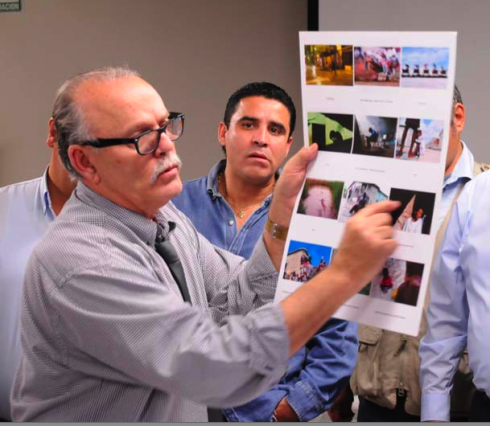
Ricardo Ferro, the veteran photographer, conducting a photo editing workshop for editors and designers at El Debate de los Mochis newspaper in Mexico. Here Ferro instructs his students to evaluate photos and avoid such expressions as “I don’t like it” or “It’s not what I need” and, instead, using intelligent criteria when deciding to use an image.

Perhaps one of the most often asked questions by newspaper managers today is that of newsroom work flow. This is a topic that is greatly influenced by whatever technical newsroom system is adopted to make things happen, but, more importantly by how the newsroom managers decide to let the work move.
To me, the process begins with redefinitions of news, reassignment of tasks, and with an honest evaluation of how each newspaper approaches the path of the story—-something we have discussed in this blog often during the past 15 months. At the heart of the discussion is the “reassigned” roles that are possible because of technology.
Every week, a top newspaper manager would ask me during the course of normal conversation what I would consider to be the ideal newsroom flow in a multiplatform world: who has it? where can we go observe it? Is it true that London’s The Telegraph holds the key to the case study of how to program newsroom work flow? Or is it Aftenposten of Norway? Could it be the Goteborgs Posten of Sweden, or El Pais of Spain?
Unfortunately, I don’t have the answer to these questions. By the way, all of the titles mentioned above DO have effective newsroom work flow examples. However, this is not a one size fits all situation. Each newsroom must devise its own practical application for work flow.
The role of photographers
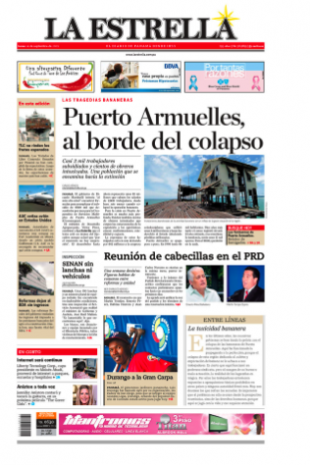
Panama’s La Estrella is one of the newspapers following Ricardo Ferro’s coaching for better photo editing and photo flow in the newsroom. “Our concept here is to take the newspaper beyond being a mirror of the images already appearing on television, or in competing newspapers. The new set up calls for each department within the newspaper to have two exclusive projects ready to go at all times. It is working,” a proud Ferro says.
Enter Ricardo Ferro, veteran star photographer from The St. Petersburg Times (Florida), and one who has done extensive consulting to photo staffs for newspapers around the world—-with emphasis on Latin America.
Ferro has his own ideas on the subject of work flow, and specifically how it applies to photos and visual images. I have had a chance to chat with my long time friend Ricardo about his new program, which takes into account technical changes that now allow reporters to take simple photos, such as headshots, freeing photographers to do concentrate on more elaborate assignments.
This started about five years ago when I started working with the newsroom staff to demonstrate that they can not treat every assignment as a news event, and as a result they convert the photo department in to a reactive bunch, that its only function is to put out fires.
As a result I started working with the employees that in one way or another ask for , take, edit , display, correct or crop, and archive the photos, and two years ago we started CheckPoint Solutions, to teach the production of videos for the WEB and most recently I train the reporters to learn how to be true pen/video multimedia communicators.
Reallocation of resources
Ferro believes that many newspapers today still have not done enough to avoid waste of time, human resources and equipment.
For example: I have found out that in a newspapers that have ten photographers in the staff ( they have 80 hours dedicated to photos ) and they take 24 photo assignments in that day, of which 10 are simple headshots for interviews etc. something that a reporter could have done in less than 10 seconds, and the real talent of the photo staff could be used more creatively, such as creating video for the online editions
To achieve this, Ferro recommends new tools, such as a digital recorder which shoots video, photos in HD. He also trains reporters as part of his work.
These are changing times that require drastic approaches to how editors assign talent in a newsroom. It begins with the reporters. It is also part of using technology to its greatest potential.
Those interested in reading more about Ricardo Ferro’s ideas for better photo assignment flow, planning and organization, can check his program NewsCONTROL written in File Maker Pro 10- for MAC or PC, English or Spanish versions, go here:
http://www.ricardoferro.org/Ricardoferro.org/NewsCONTROL.html
Note: Right now the information about this software appears here only in Spanish, but Ricardo promises to post it all in English. The software is absolutely free for those newspapers working with Ferro on his photo/newsroom flow training programs.
More about newsroom work flow
I consider this to be one of the subjects we need to discuss more often, and more thoroughly. I invite newsroom managers whose operations have found interesting and innovative ways to reorganize work flow to please let me know about it. I would very much like to do a series of profiles of effective newsroom work flow environments.

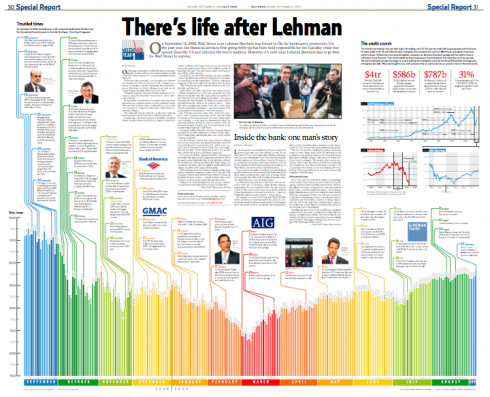
Today we bring you an informational graphic from the Gulf News (Dubai). Miguel Gomez, art director, shares this two-page graphic, by staff artist Dwynn Ronald Trazo, tracing the trajectory of the Dow Jones index for the entire year following the collapse of Lehman Brothers
Ironically, during the weekend I had read several European newspapers with various accounts of the anniversary of this most tragic day for economic news. However, most of them handled the story as a narrative. The Gulf News treatment shows the story in an incredibly visual manner, but yet, simple, to the point and conveying the magnitude of the story at a glance. That is what good storytelling is about.
Bild Zeitung: sports page that wins
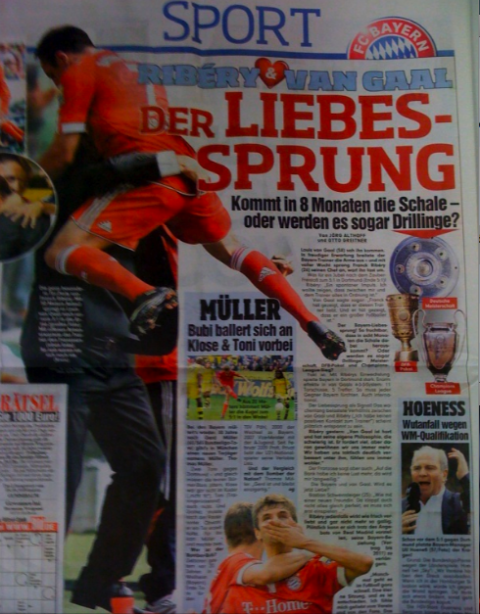
Today’s Bild Zeitung: sports page with headline and photo to match: The Love Jump. The story behind the photo: rumors have circulated that this one player doing the jumping is not in good terms with his coach. So, when the player scored a goal, he ran across the field to jump and hug the coach. Talk about a photo worth a million words
In the category of the tabloid sports page where Impact is spelled with a capital “I” I am often amazed by how consistently good the pages of Germany’s Bild Zeitung are.
True, this is not a style for every newspaper,and I know that some will take a look and turn the other way. Design must be defined in terms of how well it achieves what it is supposed to for the audience for whom it is intended. The 12 million daily readers who come to Bild Zeitung like the splash, the photo that turns, the headline that entices (The Love Jump) and the visuals that make it all come together. Chaos never looked better, if you are a Bild reader. I am one!
I also wonder how difficult it must be to do pages like this. I am convinced that many designers can succeed at the classic, sophisticated page. Doing Bild-style pages? Well, you must have been properly trained? Sort of like difficult languages that you can only imagine your mother teaching them to you.
Thoughts on the ideal art director
Working with Reed Reibstein (Yale University ‘11) always provides me with a good learning experience. You all know Reed as our Garcia Media summer intern. Reed is now back to classes at Yale. Yesterday he was pondering the ideal role of the art director.
One of Reed’s questions to me was direct and to the point:
Reed: What are the most important traits for an art director to have? I would love to hear about who you would consider an ideal art director.”
Oh, Reed, you always make me do a double take, or dig into the old bag of descriptions accumulated over the past four decades.
God knows that I have paid my dues with art directors in 86 countries. Some are memorable. A few are, indeed, forgetable. Some, I may add, have come close to driving me to drastic actions (did anyone mention the possibility of suicide?). Overall, however, art directors are good, creative souls, who mean well, work extremely hard and, in most cases, could have handled the job of the consultant single handedly. It is sad that their managers often did not think so (but this is another chapter, or a full book, on how some art directors self destruct inside their work environments on the way to the top).
To me, a sure way for an art director to self destruct is to downgrade the editors for whom he/she works. The worst art directors I ever encountered spoke badly of their editors (“This editor would not know good design if it hit him between the eyes”), and had no patience for those editors who took a little while to appreciate the cadences of a bit of white space, or an elegant font. They also did not care much about the role of teaching, inspiring and making others derive an appreciation for and an enjoyment of what good visuals can offer.
Mario’s update note: Ever since I posted this entry five hours ago, I have received 12 emails of designers who tell me about an art director they know who has engaged in the self destruction I discuss here. Apparently, this is not such an isolated situation (I should have known). The mails that I have received today tell tales of “arrogance,” an attitude of “I am God, nobody does it better….” Well, you know the rest. I wish those writing to me would “post” their comments here. One US-based magazine designer wrote a note I wish to share: “Mario, I worked for one of these self destructive art directors for three hard years. Never again. The woman was absolutely over her head, but thought she was Van Gogh. It was not funny. She sent us home crying sometimes. She disappeared, never to be heard from again. Talk about self destruction.”
Anyway, here is what I wrote to Reed last night. Call it Mario’s unedited description of what makes a good art director:
Reed, to me, a good art director is one who thinks journalistically, more than artistically.
An art director is a visual journalist, more than an artist, in the grander sense of the word.
A good art director surrounds himself/herself with great designers, then lets them create, mentors them, makes sure that each designer is assigned to that which he/she can do best.
Ultimately, a good art director leaves his ego at home, rolls up his sleeves and designs pages, reacts to the content, not to preconceived ideas of what should be.
Finally, good art directors (the happy ones I have met the past 40 years) don’t marry themselves to ONE idea and pursue it even in the face of contradictions. A good art director picks his battles.
A good art director, like a good anything, surrounds himself with people he/she may consider ten times better than himself, then everyone shines, including the art director.
A good art director believes in team work: the best idea wins.
Pure Design download: White Space
If there is one area of our craft where the guidelines have NOT changed at all it is in the use of white space: a constant in creating effective, attractive pages.
The Impact of the Compact
Pure Design: Download entire section: Type
Download entire first section of Pure Design: Words
Now that I have fully presented the first of six sections of Pure Design on TheMarioBlog, I am offering the entire initial section, “Words,” available for download—all 33 pages of it. This may be useful for those of you saving or printing out Pure Design and will be done following each of the remaining sections. At the end of our journey through words, type, layout, color, pictures, and process, I will publish the entirety of Pure Design in one file.

Monday;s best reads from the WAN/IFRA Executive News Service
– UK: Independent drops price to £1 a week for month’s trial
http://blogs.pressgazette.co.uk/wire/5565
– USA: Philadelphia’s Newspapers Face a Big Court Date
http://www.nytimes.com/2009/09/14/business/media/14philly.html?ref=media
– USA: Trust in News Media Falls to New Low in Pew Survey
http://www.nytimes.com/2009/09/14/business/media/14survey.html?ref=media
– USA: Young Guys Buy Indiana Paper, Bring It Into Twitter Era
http://www.editorandpublisher.com/eandp/news/article_display.jsp?vnu_content_id=1004011658
– Australia: Fairfax launches National Times website
http://www.theaustralian.news.com.au/story/0,25197,26067456-7582,00.html
– Australia: Print circulation ‘heading to online model’
http://www.theaustralian.news.com.au/story/0,25197,26067444-7582,00.html
– Japan: 1st Media-strategy seminar addresses the future of newspapers
http://www.pressnet.or.jp/newsb/0909b.html#Anchor-Yomiur-42123
– News Corp. Setting Up an Internal Wire Service
http://www.nytimes.com/2009/09/14/business/media/14murdoch.html?ref=media
–-NewBizNews in the Guardian
http://newsinnovation.com/2009/09/13/newbiznews-in-the-guardian/
– Good Newspapers Can Survive if They Break Their Old Culture
http://adage.com/columns/article?article_id=138934
– Ask an Expert: Newspaper ads can be important part of your media mix
http://www.usatoday.com/money/smallbusiness/columnist/strauss/2009-09-14-newspaper-advertising_N.htm
– How to Charge for News Online? Ask the Tech Giants
http://www.editorandpublisher.com/eandp/news/article_display.jsp?vnu_content_id=1004011348
– News Industry Must Innovate Marketing as Much as Journalism
http://www.poynter.org/column.asp?id=31&aid=169805
Fall is in the air
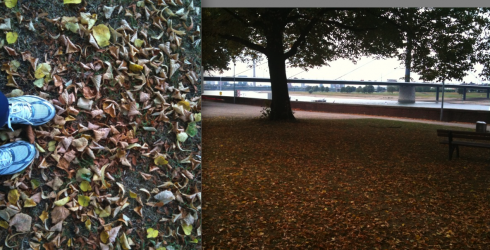
Leaves at my feet today as I took a morning run in Dusseldorf
It is not only cooler air that reminds us that fall has quickly arrived. These photos taken this Monday morning as I went for a run in Dusseldorf, right by the Rheine River. The floor is one huge tapestry of recently fallen leaves. Colorful change of season, one of my favorite times of the year.
Color for subway riders in New York City
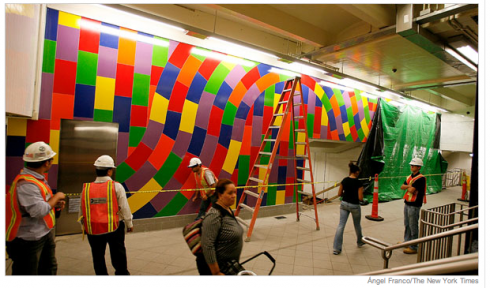
Here is the colorful display of Sol LeWitt’s work. Photo by Angel Franco/The New York Times
While on the subject of colors:
A New York Times story tells us that a giant tiled wall of jewel-toned loops and curves — one of the last commissions by the Conceptual artist Sol LeWitt — was unveiled in the 59th Street-Columbus Circle subway station by the Metropolitan Transportation Authority last week.
Nice way for the commuters to start their day, especially when it begins to get a little more gray outside with fall arriving.

Who is Jacky?
Jacky belongs to Frank Deville. The Luxembourg-based pooch is an “avid reader” of the German newspaper, Bild Am Sonntag. Every Sunday Jacky picks stories and interesting graphics in Bild Am Sonntag , the German newspaper.
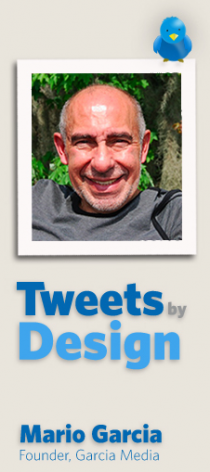
Follow me at www.twitter.com/tweetsbydesign
Follow the Marios

Two Marios. Two Views.
Follow Mario Jr. and his blog about media analysis, web design and assorted topics related to the current state of our industry.
http://garciainteractive.com/
Visit Mario Sr. daily here, or through TweetsByDesign (www.twitter.com/tweetsbydesign)
In Spanish daily: The Rodrigo Fino blog
:
To read TheRodrigoFino blog, in Spanish, go:
https://garciamedia.com/latinamerica/blog/
TheMarioBlog posting #365